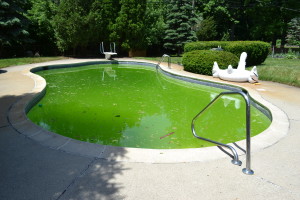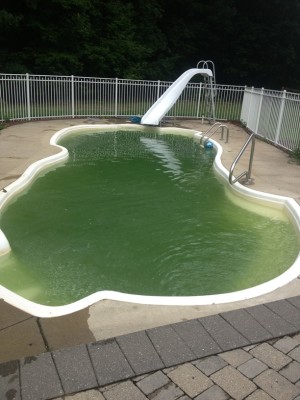Every pool owner has encountered a battle with algae at one time or another. If you keep your chlorine levels stable, this will not tend to be a problem. Storms, power outages, or forgetting to add salt to your salt water pool, or chlorine tablets to your chlorine feeder are a few reasons why your chlorine levels may drop and allow algae to grow.
Algae spores are constantly entering the pool. They are carried by wind, rain, and even your pool’s swimmers. If conditions are just right, algae blooms can appear literally overnight. The ideal conditions for blooms tend to be: out of balance water, warm temperatures (warm water), sunlight, and the presence of nitrates or carbon dioxide. These factors in combination with poor circulation or filtration, not to mention a lack of sanitation, equal algae heaven. To best figure out what is the cause of your particular algae bloom, we recommend you use a process of elimination.
Fun fact: Algae is a LIVING aquatic creature. I loves to multiply on warm, sunny days. It contains chlorophyll, like most plants, and it also uses photosynthesis to grow. It takes in carbon dioxide and releases oxygen.
What’s So Harmful About Algae, Anyways?
Well, the most obvious problem is no one will want to swim in your pool. What’s the point of having a pool if it is offending swimmers or decreasing visibility in your pool? Next to that issue, algae requires a lot of work, time, and money to get rid of once it has really begun to thrive in your pool. It is more effective to use preventative measures to protect your pool against algae than to wait for it to bloom. Algae causes cloudy water or strange colored water. Algae is not technically harmful to swimmers; however, pools with algae are better suited to harbor harmful bacteria such as E-Coli.
Another way algae can be harmful for your pool is the potential for clogged pathways. Algae can clog up pores in your filter, decreasing filter effectiveness. This will require more backwashing or even replacements. Algae can actually eat up your chlorine, causing you to be constantly adding more and more. This is time consuming and also costly. You can think of algae as a ‘weed’ in your pool. Just like if you were trying to create a beautiful garden, you would spend time to pull the weeds or add mulch to prevent them from growing. It’s the same with your pool. You need to spend the time pulling out the ‘weeds’ and the best way to do that is to prevent them from growing in the first place.
Review of the Types of Algae:
There are more than 20,000 different types of algae out there. To make it simple, people usually refer to the different types of algae by their color.
This is probably the most common type of algae Green algae likes to make its appearance after your pool experiences poor sanitation or filtration- when the water is most cloudy and hazy. It likes to ‘free float’ in the water; although it has been known to cling to the sides and the floor of the pool. Green algae, if left to thrive, can even cover large sections of your pool wall or cover the entire pool is a greenish slime.
Black algae is one algae you really want to avoid. If not treated immediately, and sometimes even if it is treated immediately, it can be very difficult to remove. It becomes difficult to remove because it forms strong roots which grow deeper than the surface of what you can see or clean. You may think you cleaned up your black algae issue only to find it back within a few days. Black algae is usually black, but it can also appear blue or green. It’s usually the size of a pencil eraser tip. Like earlier stated, they have roots that can be hard to eliminate. Their roots extend into the plaster or tile grout. If you don’t completely destroy the root, another algae bloom will form in the same spot. The tricky thing about black algae is it can form even WITH proper sanitization and chlorination. This makes it difficult to predict. Use Black Algaetrine to treat black algae.
Yellow Algae:
Yellow algae is known as a wall-clinging variety. It loves to cling to the walls of your pool (typically on the most shady side). It is sometimes referred to as ‘mustard algae’ because of it’s yellowy-mustard color. Once it spreads, you will most likely find yourself fighting the algae for the entire swim season. This particular variety is resistant to normal chlorine levels and must be treated with the proper chemicals. Yellow algae also clings to pool brushes, nets, pool toys, ladders and more, so it will be important to treat anything that comes in contact with your yellow algae pool water.
Pink Algae:
Pink algae is not technically an algae. It is actually a bacteria. It usually appears in streaks or spots in the corners of your pool. It tends to be slow to spread.
What’s the Best Way to Prevent Algae?
The absolute best way to prevent the blooming or spreading of algae is to keep your pool properly balanced, filtered, and sanitized. This alone will help protect your pool against many future issues. However, once in a while, this will not be enough. General cleanliness of the pool is important. Do you vacuum your pool regularly? It’s important to rid your pool of all organic material. They can bring in bacteria, and that will contribute to algae growth. Do you brush your pool walls and floors regularly? Not only is this a great form of exercise, it is also a good way to prevent dirt from settling into the pores of the plaster. The pores in your plaster are great starts for algae colonies.
It is also recommended to use specialty chemicals or algaecides as a back-up to normal sanitation and filtration. It is necessary for many pools. Two common chemicals used for this are: Potassium Tetraborate and Chitin.

